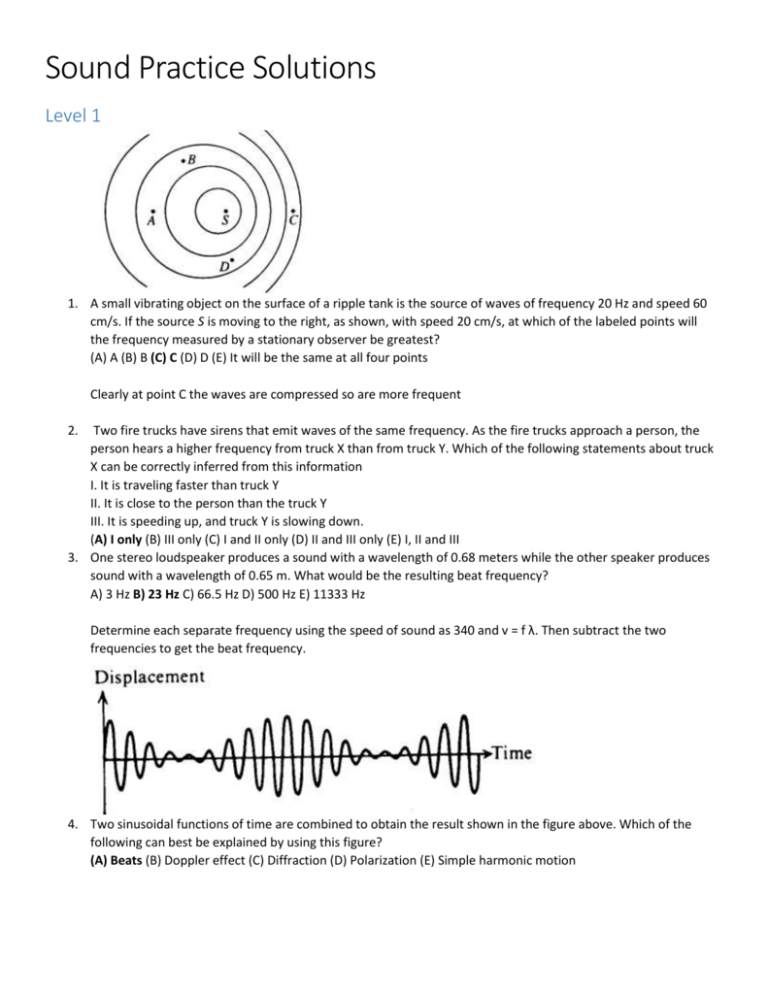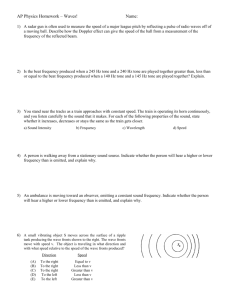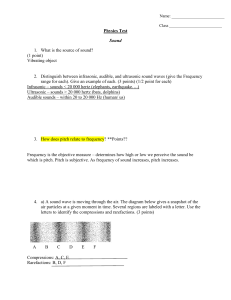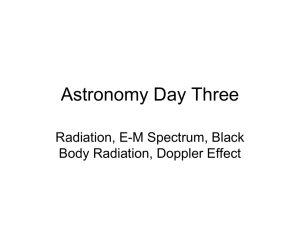Sound Practice Solutions
advertisement

Sound Practice Solutions Level 1 1. A small vibrating object on the surface of a ripple tank is the source of waves of frequency 20 Hz and speed 60 cm/s. If the source S is moving to the right, as shown, with speed 20 cm/s, at which of the labeled points will the frequency measured by a stationary observer be greatest? (A) A (B) B (C) C (D) D (E) It will be the same at all four points Clearly at point C the waves are compressed so are more frequent 2. Two fire trucks have sirens that emit waves of the same frequency. As the fire trucks approach a person, the person hears a higher frequency from truck X than from truck Y. Which of the following statements about truck X can be correctly inferred from this information I. It is traveling faster than truck Y II. It is close to the person than the truck Y III. It is speeding up, and truck Y is slowing down. (A) I only (B) III only (C) I and II only (D) II and III only (E) I, II and III 3. One stereo loudspeaker produces a sound with a wavelength of 0.68 meters while the other speaker produces sound with a wavelength of 0.65 m. What would be the resulting beat frequency? A) 3 Hz B) 23 Hz C) 66.5 Hz D) 500 Hz E) 11333 Hz Determine each separate frequency using the speed of sound as 340 and v = f λ. Then subtract the two frequencies to get the beat frequency. 4. Two sinusoidal functions of time are combined to obtain the result shown in the figure above. Which of the following can best be explained by using this figure? (A) Beats (B) Doppler effect (C) Diffraction (D) Polarization (E) Simple harmonic motion 5. A small vibrating object S moves across the surface of a ripple tank producing the wave fronts shown above. The wave fronts move with speed v. The object is traveling in what direction and with what speed relative to the speed of the wave fronts produced? Answer: B 6. A train whistle has a frequency of 100 hertz as heard by the engineer on the train. Assume that the velocity of sound in air is 330 meters per second. If the train is approaching a stationary listener on a windless day at a velocity of 30 meters per second, the whistle frequency that the listener hears is most nearly (A) 90 Hz (B) 110 Hz (C) 120 Hz (D) 240 Hz (E) 300 Hz 7. The diagrams below represent 5 different standing sound waves set up inside of a set of organ pipes 1 m long 8. What is the length of the longest wavelength shown? A) 0.5 m B) 0.75 m C) 1 m D) 2 m E) 4m Cx is only ¼ of a wavelength. To make a full wavelength you would need 4x the current length 9. Which organ pipe(s) shows a standing wave which has twice the frequency of one of the other waves shown? A) Cy B) Cz C) Ox D) Oy E) Cy , Cz, Ox, Oy Wavelengths of each are (dist/cycle) … 4L, 4/3 L, 4/5 L, L, 2/3 L … Frequencies are f = v/ λ. v/4L, 3v/4L, 5v/4L, v/L, 3v/2L … Oy is 2x Cy 10. 11. 12.










